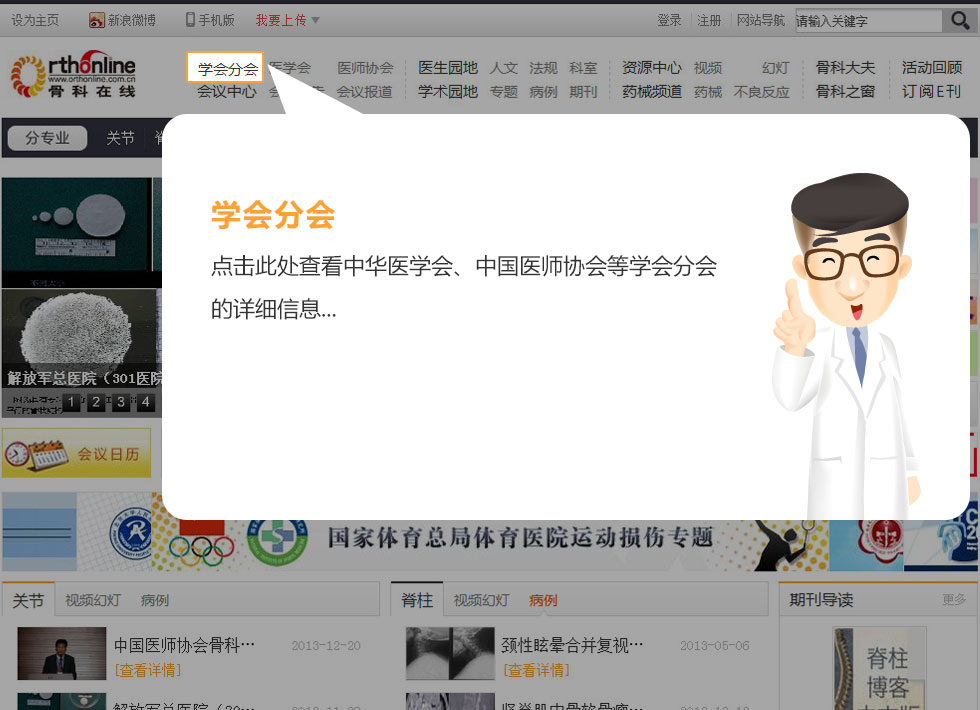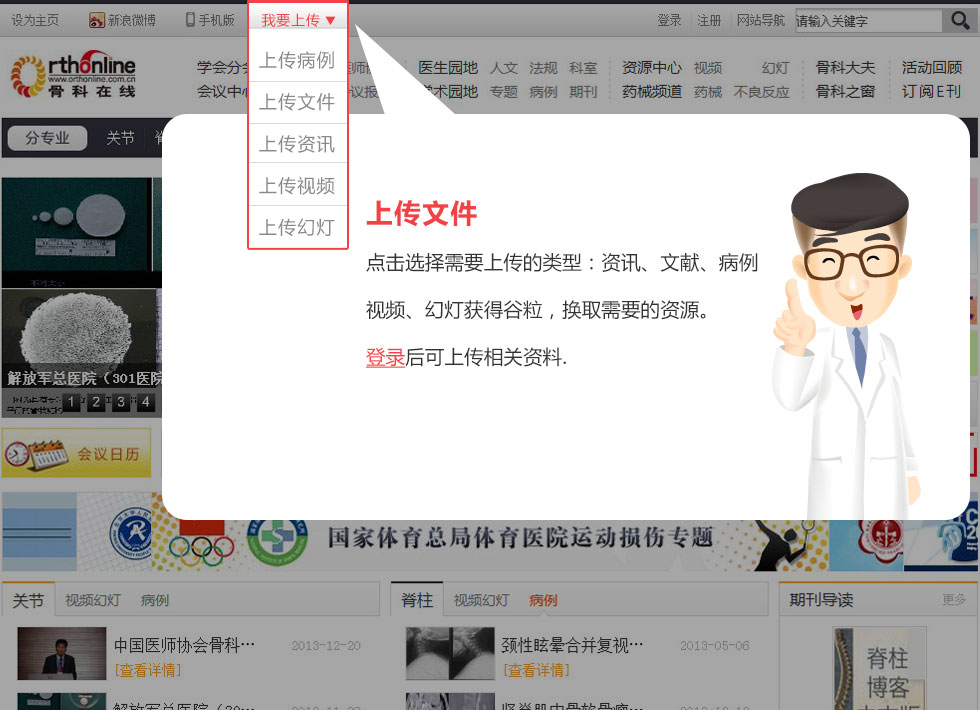自体软骨细胞移植临床进展
2013-06-02 文章来源:齐义营 施培华 欧阳宏伟 (中华骨科2008年第一期) 我要说
骨科在线版权所有,如需转载请注明来自本网站
一、简介
关节软骨主要是由少量的软骨细胞和细胞外基质组成的无血管组织,软骨损伤后,自我修复能力很弱,当关节软骨缺损超过一定面积(>2 cm2)、大于4mm的全层软骨缺损通常不能自行修复,持续发展会导致骨关节炎,给病人带来很大痛苦。关节软骨的修复问题是面临的一大挑战,关节镜下清创灌洗术、微骨折术、开放性自体骨膜移植术、自体骨软骨移植术和自体软骨细胞移植(ACI) 是目前可选的治疗方法。但传统修复方法新生组织主要是纤维软骨,而且与正常软骨有不同的机械特性。自体软骨细胞移植是近年来出现的一种新的治疗手段,自1987年瑞典医学家Peterson等首次对兔子实施自体软骨细胞移植术成功,1994年自体软骨细胞移植(ACI)首次应用于临床[1],至2005年已有超过12000例病人接受了这一治疗[2]。目前对于ACI 的临床疗效报道越来越多,本文对世界范围内从自体软骨细胞移植开展以来的有关短、中、长期疗效的临床研究做了系统总结和阐述。
二. 自体软骨细胞移植的程序
并不是所有的软骨缺损患者都适合自体软骨细胞移植,最终决定是否适合取决于关节镜的检查,一旦决定可以,关节镜检查的同时即可获取软骨,从而体外培养软骨细胞,为以后的移植做准备。所以自体软骨细胞移植的程序主要包括四步即术前的关节软骨活检、软骨细胞的体外培养、细胞移植和术后的功能锻炼。
1.关节软骨活检 每一位接受做ACI的病人必须经关节镜下活检,检查缺损的部位和范围,并决定是否适合做细胞移植,如适合可在合适部位取下软骨(非负重区),面积约为0.5cm×1.0cm,约200–300 mg.此外,病人也要符合一定的条件,手术部位无感染、无感染性疾病、无恶性肿瘤病史等,年龄的问题似乎不再受限。[2]
2.软骨细胞体外培养 从非负重部位获得软骨或从损伤部位获得的软骨[3]经酶消化获得软骨细胞,经培养,繁殖,大约需要两周,达到一定数量, 约5 × 106 个,便可用做移植.复层培养有利于细胞分布、表型恢复、组织整和、维持生物学功能。
3.细胞移植 把体外培养的软骨细胞以悬浊液形式注射到缺损部位,用骨膜或其它生物膜缝合缺损,防止移植的软骨细胞脱落以及软骨细胞分泌的胶原和蛋白多糖的流失等。 或者在移植前把细胞预先培养在生物支架上使充分黏附,这对维持软骨细胞的生命力和形成特定组织起重要作用,然后一起移植到缺损部位,不用缝合[4],这种方法应用广泛。
4.移植后复原 康复治疗对治疗效果起到一定作用,术后要制动48h,可适当进行肌肉和关节的收缩运动,以后适量做些运动,1-2个月后扶拐可负一定重量,要完全负重要根据临床治疗效果和个人情况,不同缺损部位康复治疗方案不完全一样[5]。
三.发展趋势
自体软骨细胞移植大体说有三种方法,从先前的细胞附和骨膜移植到细胞和生物膜的移植,再到细胞和三维支架的移植,方法的改进使得手术操作更加方便,能增加手术效率和治疗效果,现在细胞和三维支架移植迅速发展并得到广泛的应用。
1.第一种方法 关节镜下取关节软骨,经酶处理后,分离软骨细胞,体外培养,扩增一定数量后,用于移植.关节切开,从非负重部位取骨膜,覆盖缺损,然后缝合, 把含悬浮软骨细胞的培养液注射到缺损部位,纤维凝胶密封.这种方法有许多缺点:细胞悬浊液的外漏,骨膜与周围组织的反应,骨膜的周围组织分离,骨膜的增生等.
2.第二种方法 前面的过程和1相同,所不同的是,不是用骨膜,而是用一些生物膜如胶原膜等与周围组织缝合,避免了骨膜的那些并发症,然后把含软骨细胞的培养液注射到下面.这个过程免去了取骨膜的步骤,缩短手术时间,使病人免受一次痛苦.
3.第三种方法 与前两个方法不同,它是把经体外培养获得的软骨细胞预先培养在可降解吸收的生物支架上,然后一起移植到缺损部位.这种支架要经过处理,使它的形状大小与缺损部位一样。它不需要骨膜或胶原膜覆盖,还能提供细胞依附和生长的三维环境,手术操作简单,侵犯性小,在关节镜下成为现实[3, 6],而且方便于移植到较难操作部位,这样随着支架的降解,软骨逐渐形成,缺损一步步被填补.现在各种各样的三维支架正在研究和实验中.
四.临床应用
自体软骨细胞移植(ACI)和基质相关的自体软骨细胞移植(MACI)已较广泛的被应用于临床,统计已发表的65篇国际临床随访专业文献[7] [1, 3, 4, 6, 8-53][54-65]共报道了3634例,其中0到2年随访2179例,2年以上到5年之间随访1067例,五年以上随访395例,有效率约70%-90%,功能明显改进,症状明显减轻,有的甚至能维持长达11年。具体如下
(1)随访0到2年的病例有2179例,有效率约为70%-85%,其中代表性研究如下:
Erggelet, C., et al[7]对1051位接受自体软骨细胞移植的患者做了随访,其中随访1年588例,2年220例,61.2%缺损在股骨髁,面积约4.6cm2,损伤等级多数为3-4级,根据modified Cincinnati knee rating system,85%患者获得好的效果。
Minas, T[43]对169名接受ACI治疗的患者做了研究,随访1年107例,随访2年56例,根据the modified Cincinnati knee rating scale, Short Form-36, Knee Society score, Western Ontario McMaster Universities Osteoarthritis Index score和患者满意程度等方面评估,87%患者症状明显改进,
(2)随访2年以上到5年的病例有1067例,有效率约为80%-90%,其中代表性研究如下:
Marcacci, M., et al[49].对141位接受MACI(Hyalograft C)治疗的患者做了2-5年的随访,平均38个月,根据the International Knee Documentation Committee subjective evaluation,91.5%患者功能改进,根据the EuroQol-EQ5D measure,76%患者没有疼痛,88%患者运动正常,经组织学检查多数是透明样软骨修复。
Erggelet, C[57]对24位接受ACI治疗的患者做了5年随访,这些患者损伤程度IV级,平均缺损面积6.27cm2,经治疗后85%-95%患者获得很好的效果。
(3)随访5年以上的病例有395例,有效率约为75%-90%,全部研究如下:
Browne, J.E., et al[58]对87名患者做了5年随访,平均缺损面积4.9cm2,根据Modified 10-point scales of the Cincinnati knee rating system对治疗后的临床效果做了评估,62人功能明显改进,平均提高4.1分,有效率约为71%。。
Peterson, L., et al[61]对58名接受ACI治疗患者做了研究,缺损都在股骨髁,平均面积为5.7cm2平均深度7.8mm,经过平均5.6年的随访,根据临床医生评估91%获得很好的效果,患者自我评定93%功能明显改进。
Peterson, L., et al[59]对94名接受ACI治疗的患者做了2-9年的随访,从临床评定等级、关节镜和组织学方面做了评估,单纯的股骨髁缺损患者92%获得很好效果,分离性骨软骨炎为89%,股骨髁合并前交叉韧带损伤为75%,多处损伤为67%。对53名患者关节镜检查发现缺损填充较好、与下层的骨黏附较好、与周围的软骨整和完全、和正常的软骨硬度相当。
Lindahl, A[60].,对57名接受ACI治疗的患者做了平均7.3年的随访,88%患者获得很好的效果,股骨髁缺损患者85%(28/33)获得很好的效果,股骨髁合并前交叉韧带损伤患者为100%(5/5)、分离性骨软骨炎患者为87.5%(7/8)、髌骨损伤为82% (9/11)。治疗前57位病人都有残疾,随访7.3年后,44位没有任何症状、10位残疾明显减轻。
Peterson, L., et al [62]对61名接受ACI治疗的患者做了长达5-11年的随访,平均7.4年,经治疗2年后50名患者获得很好的临床效果,5-11年后,51名患者获得很好临床效果。而且新生软骨的硬度达到正常软骨的90%,活检显示透明软骨的性质。
总结上述临床报道,ACI修复软骨缺损的短中期效果肯定,治疗效果优良,长期效果与短中期报道一致,但长期效果的随访病例相对较少,所以还要进一步验证。
五.ACI与其它治疗方法的比较
目前治疗软骨缺损的方法较多,有关节镜下清创灌洗术、微骨折术、开放性自体骨膜移植术、自体骨软骨移植术、自体软骨细胞移植等,但目前有关各种方法疗效的比较评价甚少近来已有一些临床比较ACI与其它方法的疗效。具体信息如下:
1.ACI与骨软骨移植(mosaicplasty或osteochondral cylinder transplantation)的比较
骨软骨移植在缺损面积较小的情况下能恢复关节软骨的高度和形状,但如果面积大于2cm2,病人有较高的功能要求,这种方法受到限制,需要几个移植物,对供体部位产生影响,而且形成的是纤维软骨[6]。而ACI可以满足以上要求,经ACI治疗,效果比较好,有明显的透明软骨形成,功能恢复好,1年后ACI治疗效果优于mosaicplasty[66]。Bentley G[67]在2003年对这两种方法做了比较,100名膝关节软骨缺损患者,平均年龄31.3岁,都是外伤引起,平均面积4.66 cm2,58名接受ACI,42名接受mosaicplasty,根据modified Cincinatti[68] 和 Stanmore 评分及客观临床评价,88%接受ACI患者获得好的结果,接受mosaicplasty治疗患者为69%。1年后关节镜检查82%修复很好,而mosaicplasty仅为34%。
但是,Horas U等[69]2005年对这两种方法的临床效果和组织学做了比较,40名股骨髁突损伤患者随机接受ACI或osteochondral cylinder transplantation (OCT)治疗,术后2年,活检标本经组织学染色,免疫组化,扫描电镜处理,经ACI治疗形成的主要是纤维软骨,在缺损处形成完整的稳定的有一定力学特性的软骨表面,而经OCT治疗形成的是透明软骨,但与周围正常的软骨有明显的分界,缺损未完全填补,两种方法都能减轻症状,但短期疗效ACI落后于OCT.
2.ACI 与微骨折术、清创术的比较
与清创术比较:在减轻痛苦和关节膨胀方面显著,经治疗后关节功能恢复较好,形成的透明软骨多,术后生活质量较高[51]。Fu FH[51]针对ACI 与清创术临床效果比较做了3年随访。54例接受ACI治疗,42例接受清创术治疗,经ACI治疗的患者在减轻疼痛和膨胀感及关节功能的恢复方面明显,81%接受ACI治疗患者获得好的效果,而清创术为60%。Knutsen[35]对80名接受ACI(40人)和微骨折术(40人)治疗股骨髁软骨缺损的效果做了比较,术后2年,组织学观察,都获得了很好的治疗效果,两组的差别很小,都没有严重并发症。Bachmann [34]对MACI和微骨折术治疗软骨缺损的效果做了比较,术后2年,无论从临床症状、缺损再生情况还是从客观评分,MACI明显优于微骨折术。
3.ACI与MACI的比较
支架的研究是MACI的核心,现在各种各样的三维支架在研究和试验中,包括天然的可降解的物质,如去矿化骨基质、纤维凝胶、1型胶原、2 型胶原、透明质酸等;人工合成的可降解的聚合物, PGA、PLA、PLGA等和人工合成的不可降解的物质。各种各样的支架能提供三维空间,防止细胞流失,维持移植细胞的表现型,提供一定的机械力量,有利于细胞的移动,使细胞能有效进行气体交换、营养吸收、废物排出,因而更有利于细胞基质的分泌,提高修复效果[70]。目前临床上用的主要是胶原、纤维凝胶及透明质酸支架。
MACI能有利于细胞的分化,并维持一定的形态,缩短手术治疗时间[4],有利于病人的复原。 Bartlett W等[9]对两种方法做了比较,他们移植软骨细胞时用胶原覆盖缺损(ACI-C),或是用双层胶原做载体移植软骨细胞(MACI)。有94例患者,44人接受ACI-C,47人接受MACI。ACI-C 组modified Cincinnati knee score[68]增加17.6分,MACI组增加19.6分。1年后关节镜检查79.2% ACI-C组 和 66.6% MACI组 获得极好效果。1年后活检发现43.9% ACI-C组 和 36.4% MACI组有透明软骨或是透明软骨和纤维软骨混合。两种方法都能很好的修复软骨缺损。
Clar C[71]等在2005年对各种治疗方法的临床效果和费用-效应做了研究。四个随即对照实验,总数266位病人。两个比较ACI与 mosaicplasty,一个比较ACI与microfracture,另一个比较MACI与 microfracture。其中一个研究随访1年,其余三个随访3年。ACI与 mosaicplasty相比,1年后ACI治疗效果明显优于mosaicplasty, 经mosaicplasty治疗患者69%获得较好效果,而ACI88%获得较好效果,经活检一半以上为透明软骨。但是第二组ACI与 mosaicplasty几乎没有明显差别。ACI与microfracture相比,2年后临床效果仅有小的差异,第四组没有充分的长期结果,但是显示了MACI的可行性。经ACI治疗的患者生活质量高于微骨折术70%-100%,但是费用较高,每个生活质量调整寿命年(quality-adjusted life-year,QALY)费用效应阈值约20000-30000英镑。现在还没有充足的证据说明ACI的费用-效应优于microfracture或mosaicplasty,需要长期来评定。但ACI似乎优越,因为形成的是透明软骨,耐磨,而且从长远来看能防止骨关节炎的发生。
六.ACI并发症
ACI的并发症较少出现,如有并发症,经常是在移植后前两年,主要有骨膜的增生[2, 59]、与周围组织整和不良,骨膜瓣的分叶[2],关节内粘连[2, 59],移植失败,感染等,以骨膜的增生, 骨膜瓣的分叶和关节内粘连较常见[2]。许多并发症经关节镜修整后明显改进[59]
据美国食品药物调查局从1996-2003年调查报道[72],在随访的7500例中,不良反应发生率为3.8%,共294例患者,其中有497个并发症,并发症被诊断的中位时间是240天。并发症发生的患者平均年龄38岁,63%是男性。报道最多的是移植失败(25%,73例),骨膜瓣的分叶(22%,65例),组织增生(18%,32例。)此外,还有手术部位感染。93%的并发症发生患者(273例)移植后需要手术矫正,原因包括移植相关问题(48.1%),与周围组织的问题(16.2%),关节内的问题(16.2%)。严重失败的仍然需要膝关节置换。
七.存在的问题
自体软骨细胞移植修复软骨缺损能获得很好的效果,比传统的治疗方法优越,但也不是完美的,也存在许多问题[73]:1.软骨细胞的来源有限,而移植需要大量细胞,许多由于在体外培养过程中没有达到移植所需的细胞数量而失去治疗机会。2.软骨细胞在体外培养过程中存在反分化现象,而且寿命短。3.获取软骨对供体部位产生影响。4. 新生的软骨的性质,修复组织多数是透明软骨和纤维软骨的混合,而且机械性能与正常软骨有差异。5 .移植后的软骨细胞能否继续分泌2型胶原,维持表现型。6 .新生的组织生物力学是否符合要求,长期是否会退变,从长远来看是否能预防骨关节炎的发生。7.修复软骨缺损的费用较高[71]。这些问题都需要进一步解决。
八.结论
自体软骨细胞移植主要以透明样软骨组织修复缺损区[16],移植的软骨细胞在1年后能产生II型胶原,并继续分化和成熟[16]。经证实与周围正常软骨、软骨下骨整合较好[22],同时修复软骨组织的硬度与正常关节软骨硬度相当[71]。自体软骨细胞移植术的效果比微骨折术[51]、骨软骨移植[66, 67]、软骨移植、骨膜移植好,但费用似乎较高,是目前治疗软骨缺损的较理想的方法,各种方法的花费-疗效比较还要进一步研究。治疗效果与年龄、时间、面积、部位等有关,年轻患者,小于2年的病史,单个缺损(缺损在滑车或股骨髁突),术后恢复好[71],自体软骨细胞移植甚至对并发骨软骨炎患者也有较好效果[43],其早短期和中期效果肯定,术后长达11年也能维持较好效果,但由于随访超过5年时间报道较少,其长期效果还要进一步研究。透明软骨的再生与临床效果有很大的联系,起始的好的临床效果与其长期效果是一致的[59],及早的治疗对预后很重要[71]。
九.展望
自体软骨细胞移植在治疗膝关节软骨缺损方面已得到较广泛的应用,在踝关节、肘关节软骨、距骨等的临床应用也迅速发展,目前还没有哪种方法能完好的修复关节软骨,并可保证其长期效果。基质相关的自体软骨细胞移植越来越受欢迎,为以后研究指明方向,三维支架有利于细胞的生长、维持分化,在临床应用中取得了很大的进步,大多数患者能获得很好的结果,但也存在很多问题。充足的细胞来源是需要解决的难题,寻找另外一种有效的细胞是研究的重点,骨髓来源的间充质干细胞似乎更具有优势,基质相关的间充质干细胞移植似乎更能引起研究者兴趣,在动物实验中取得较好结果,Wakitani[74]等证实了其临床可行性。但间充质干细胞的生物学知识尚不足够,间充质干细胞在临床应用修复软骨之前,其分离纯化、特异性标志物寻找、诱导向软骨分化状态控制等等科学问题尚待解决。另外目前的自体软骨细胞移植技术尚不能很好治疗超大的软骨缺损,所以除了细胞和支架的研究外,如何改变关节腔的修复环境以及更安全有效利用生长因子也尚待更多研究。
通讯作者简介:
欧阳宏伟 浙江大学教授、博士生导师。亚洲软骨修复学会委员和中国组织工程学会委员。长期专注于骨科组织工程基础和临床工作。2005年10月回国前以 clincal scientist身份带领新加坡国立大学附属医院临床组织工程研究小组和东南亚唯一的临床组织工程实验室。该实验室已完成百余例临床自体软骨细胞移植治 疗。近4年来在《Tissue Engineering》,《American Journal of sports medicine》,《Journal of Biomedical Material Research》,等国际权威专业期刊/会议上发表国际论文40余篇。
作者网页 http://www.cmm.zju.edu.cn/news/show.php?id=735
参考文献
1. Brittberg M, Lindahl A, Nilsson A, et al. Treatment of deep cartilage defects in the knee with autologous chondrocyte transplantation. N Engl J Med. 1994,331:889-895.
2. Marlovits S, Zeller P, Singer P, et al. Cartilage repair: generations of autologous chondrocyte transplantation. Eur J Radiol. 2006,57:24-31.
3. Ferruzzi A, Calderoni P, Grigolo B, et al. Autologous chondrocytes implantation: indications and results in the treatment of articular cartilage lesions of the knee. Chir Organi Mov. 2004,89:125-134.
4. Bartlett W, Gooding CR, Carrington RW, et al. Autologous chondrocyte implantation at the knee using a bilayer collagen membrane with bone graft. A preliminary report. J Bone Joint Surg Br. 2005,87:330-332.
5. Hambly K, Bobic V, Wondrasch B, et al. Autologous chondrocyte implantation postoperative care and rehabilitation: science and practice. Am J Sports Med. 2006,34:1020-1038.
6. Cherubino P, Grassi FA, Bulgheroni P, et al. Autologous chondrocyte implantation using a bilayer collagen membrane: a preliminary report. J Orthop Surg (Hong Kong). 2003,11:10-15.
7. Erggelet C, Browne JE, Fu F, et al. Autologous chondrocyte transplantation for treatment of cartilage defects of the knee joint. Clinical results]. Zentralbl Chir. 2000,125:516-522.
8. Handl M, Trc T, Hanus M, et al. [Autologous chondrocyte implantation in the treatment of cartilage lesions of ankle joint.]. Acta Chir Orthop Traumatol Cech. 2007,74:29-36.
9. Bartlett W, Skinner JA, Gooding CR, et al. Autologous chondrocyte implantation versus matrix-induced autologous chondrocyte implantation for osteochondral defects of the knee: a prospective, randomised study. J Bone Joint Surg Br. 2005,87:640-645.
10. Podskubka A, Povysil C, Kubes R, et al. [Treatment of deep cartilage defects of the knee with autologous chondrocyte transplantation on a hyaluronic Acid ester scaffolds (Hyalograft C)]. Acta Chir Orthop Traumatol Cech. 2006,73:251-263.
11. Visna P, Pasa L, Cizmar I, et al. Treatment of deep cartilage defects of the knee using autologous chondrograft transplantation and by abrasive techniques--a randomized controlled study. Acta Chir Belg. 2004,104:709-714.
12. Kish G, Hangody L. A prospective, randomised comparison of autologous chondrocyte implantation versus mosaicplasty for osteochondral defects in the knee. J Bone Joint Surg Br. 2004,86:619; author reply 619-620.
13. Yates JW, Jr. The effectiveness of autologous chondrocyte implantation for treatment of full-thickness articular cartilage lesions in workers' compensation patients. Orthopedics. 2003,26:295-300; discussion 300-291.
14. Handl M, Trc T, Hanus M, et al. [Therapy of severe chondral defects of the patella by autologous chondrocyte implantation]. Acta Chir Orthop Traumatol Cech. 2006,73:373-379.
15. Visna P, Pasa L, Hart R, et al. [Treatment of deep chondral defects of the knee using autologous chondrocytes cultured on a support--results after one year]. Acta Chir Orthop Traumatol Cech. 2003,70:356-362.
16. Briggs TW, Mahroof S, David LA, et al. Histological evaluation of chondral defects after autologous chondrocyte implantation of the knee. J Bone Joint Surg Br. 2003,85:1077-1083.
17. Henderson IJ, Tuy B, Connell D, et al. Prospective clinical study of autologous chondrocyte implantation and correlation with MRI at three and 12 months. J Bone Joint Surg Br. 2003,85:1060-1066.
18. Koulalis D, Schultz W, Heyden M. Autologous chondrocyte transplantation for osteochondritis dissecans of the talus. Clin Orthop Relat Res. 2002:186-192.
19. Trattnig S, Ba-Ssalamah A, Pinker K, et al. Matrix-based autologous chondrocyte implantation for cartilage repair: noninvasive monitoring by high-resolution magnetic resonance imaging. Magn Reson Imaging. 2005,23:779-787.
20. Lohnert J. [Regeneration of hyalin cartilage in the knee joint by treatment with autologous chondrocyte transplants--initial clinical results]. Langenbecks Arch Chir Suppl Kongressbd. 1998,115:1205-1207.
21. Haddo O, Mahroof S, Higgs D, et al. The use of chondrogide membrane in autologous chondrocyte implantation. Knee. 2004,11:51-55.
22. Henderson I, Francisco R, Oakes B, et al. Autologous chondrocyte implantation for treatment of focal chondral defects of the knee--a clinical, arthroscopic, MRI and histologic evaluation at 2 years. Knee. 2005,12:209-216.
23. Vasara AI, Nieminen MT, Jurvelin JS, et al. Indentation stiffness of repair tissue after autologous chondrocyte transplantation. Clin Orthop Relat Res. 2005:233-242.
24. Tins BJ, McCall IW, Takahashi T, et al. Autologous chondrocyte implantation in knee joint: MR imaging and histologic features at 1-year follow-up. Radiology. 2005,234:501-508.
25. Pavesio A, Abatangelo G, Borrione A, et al. Hyaluronan-based scaffolds (Hyalograft C) in the treatment of knee cartilage defects: preliminary clinical findings. Novartis Found Symp. 2003,249:203-217; discussion 229-233, 234-208, 239-241.
26. Robinson D, Ash H, Aviezer D, et al. Autologous chondrocyte transplantation for reconstruction of isolated joint defects: the Assaf Harofeh experience. Isr Med Assoc J. 2000,2:290-295.
27. Richardson JB, Caterson B, Evans EH, et al. Repair of human articular cartilage after implantation of autologous chondrocytes. J Bone Joint Surg Br. 1999,81:1064-1068.
28. Bahuaud J, Maitrot RC, Bouvet R, et al. [Implantation of autologous chondrocytes for cartilagenous lesions in young patients. A study of 24 cases]. Chirurgie. 1998,123:568-571.
29. Whittaker JP, Smith G, Makwana N, et al. Early results of autologous chondrocyte implantation in the talus. J Bone Joint Surg Br. 2005,87:179-183.
30. Gobbi A, Kon E, Berruto M, et al. Patellofemoral full-thickness chondral defects treated with Hyalograft-C: a clinical, arthroscopic, and histologic review. Am J Sports Med. 2006,34:1763-1773.
31. Henderson IJ, Lavigne P. Periosteal autologous chondrocyte implantation for patellar chondral defect in patients with normal and abnormal patellar tracking. Knee. 2006,13:274-279.
32. Ronga M, Grassi FA, Manelli A, et al. Tissue engineering techniques for the treatment of a complex knee injury. Arthroscopy. 2006,22:576 e571-573.
33. Gooding CR, Bartlett W, Bentley G, et al. A prospective, randomised study comparing two techniques of autologous chondrocyte implantation for osteochondral defects in the knee: Periosteum covered versus type I/III collagen covered. Knee. 2006,13:203-210.
34. Bachmann G, Basad E, Lommel D, et al. [MRI in the follow-up of matrix-supported autologous chondrocyte transplantation (MACI) and microfracture]. Radiologe. 2004,44:773-782.
35. Knutsen G, Engebretsen L, Ludvigsen TC, et al. Autologous chondrocyte implantation compared with microfracture in the knee. A randomized trial. J Bone Joint Surg Am. 2004,86-A:455-464.
36. Amin AA, Bartlett W, Gooding CR, et al. The use of autologous chondrocyte implantation following and combined with anterior cruciate ligament reconstruction. Int Orthop. 2006,30:48-53.
37. Trattnig S, Pinker K, Krestan C, et al. Matrix-based autologous chondrocyte implantation for cartilage repair with HyalograftC: two-year follow-up by magnetic resonance imaging. Eur J Radiol. 2006,57:9-15.
38. Minas T, Bryant T. The role of autologous chondrocyte implantation in the patellofemoral joint. Clin Orthop Relat Res. 2005:30-39.
39. Muller-Horvat C, Schick F, Claussen CD, et al. [MRI monitoring of autologous hyaline cartilage grafts in the knee joint: a follow-up study over 12 months]. Rofo. 2004,176:1776-1785.
40. Horas U, Schnettler R, Pelinkovic D, et al. [Osteochondral transplantation versus autogenous chondrocyte transplantation. A prospective comparative clinical study]. Chirurg. 2000,71:1090-1097.
41. Sharpe JR, Ahmed SU, Fleetcroft JP, et al. The treatment of osteochondral lesions using a combination of autologous chondrocyte implantation and autograft: three-year follow-up. J Bone Joint Surg Br. 2005,87:730-735.
42. Micheli LJ, Browne JE, Erggelet C, et al. Autologous chondrocyte implantation of the knee: multicenter experience and minimum 3-year follow-up. Clin J Sport Med. 2001,11:223-228.
43. Minas T. Autologous chondrocyte implantation for focal chondral defects of the knee. Clin Orthop Relat Res. 2001:S349-361.
44. Andereya S, Maus U, Gavenis K, et al. [First clinical experiences with a novel 3D-collagen gel (CaReS) for the treatment of focal cartilage defects in the knee]. Z Orthop Ihre Grenzgeb. 2006,144:272-280.
45. Dorotka R, Kotz R, Trattnig S, et al. [Mid-term results of autologous chondrocyte transplantation in knee and ankle. A one- to six-year follow-up study]. Z Rheumatol. 2004,63:385-392.
46. Mithofer K, Peterson L, Mandelbaum BR, et al. Articular cartilage repair in soccer players with autologous chondrocyte transplantation: functional outcome and return to competition. Am J Sports Med. 2005,33:1639-1646.
47. Halbrecht JL, Klick BC. Improvement in bone homeostasis following autologous chondrocyte implantation of the knee. Orthopedics. 2006,29:61-69.
48. Mithofer K, Minas T, Peterson L, et al. Functional outcome of knee articular cartilage repair in adolescent athletes. Am J Sports Med. 2005,33:1147-1153.
49. Marcacci M, Berruto M, Brocchetta D, et al. Articular cartilage engineering with Hyalograft C: 3-year clinical results. Clin Orthop Relat Res. 2005:96-105.
50. Nehrer S, Domayer S, Dorotka R, et al. Three-year clinical outcome after chondrocyte transplantation using a hyaluronan matrix for cartilage repair. Eur J Radiol. 2006,57:3-8.
51. Fu FH, Zurakowski D, Browne JE, et al. Autologous chondrocyte implantation versus debridement for treatment of full-thickness chondral defects of the knee: an observational cohort study with 3-year follow-up. Am J Sports Med. 2005,33:1658-1666.
52. Behrens P, Bitter T, Kurz B, et al. Matrix-associated autologous chondrocyte transplantation/implantation (MACT/MACI)--5-year follow-up. Knee. 2006,13:194-202.
53. Krishnan SP, Skinner JA, Bartlett W, et al. Who is the ideal candidate for autologous chondrocyte implantation? J Bone Joint Surg Br. 2006,88:61-64.
54. Henderson I, Gui J, Lavigne P. Autologous chondrocyte implantation: natural history of postimplantation periosteal hypertrophy and effects of repair-site debridement on outcome. Arthroscopy. 2006,22:1318-1324 e1311.
55. Krishnan SP, Skinner JA, Carrington RW, et al. Collagen-covered autologous chondrocyte implantation for osteochondritis dissecans of the knee: two- to seven-year results. J Bone Joint Surg Br. 2006,88:203-205.
56. Micheli LJ, Moseley JB, Anderson AF, et al. Articular cartilage defects of the distal femur in children and adolescents: treatment with autologous chondrocyte implantation. J Pediatr Orthop. 2006,26:455-460.
57. Erggelet C, Steinwachs MR, Reichelt A. The operative treatment of full thickness cartilage defects in the knee joint with autologous chondrocyte transplantation. Saudi Med J. 2000,21:715-721.
58. Browne JE, Anderson AF, Arciero R, et al. Clinical outcome of autologous chondrocyte implantation at 5 years in US subjects. Clin Orthop Relat Res. 2005:237-245.
59. Peterson L, Minas T, Brittberg M, et al. Two- to 9-year outcome after autologous chondrocyte transplantation of the knee. Clin Orthop Relat Res. 2000:212-234.
60. Lindahl A, Brittberg M, Peterson L. Health economics benefits following autologous chondrocyte transplantation for patients with focal chondral lesions of the knee. Knee Surg Sports Traumatol Arthrosc. 2001,9:358-363.
61. Peterson L, Minas T, Brittberg M, et al. Treatment of osteochondritis dissecans of the knee with autologous chondrocyte transplantation: results at two to ten years. J Bone Joint Surg Am. 2003,85-A Suppl 2:17-24.
62. Peterson L, Brittberg M, Kiviranta I, et al. Autologous chondrocyte transplantation. Biomechanics and long-term durability. Am J Sports Med. 2002,30:2-12.
63. Takahashi T, Tins B, McCall IW, et al. MR appearance of autologous chondrocyte implantation in the knee: correlation with the knee features and clinical outcome. Skeletal Radiol. 2006,35:16-26.
64. Robertson WB, Fick D, Wood DJ, et al. MRI and clinical evaluation of collagen-covered autologous chondrocyte implantation (CACI) at two years. Knee. 2007,14:117-127.
65. Henderson IJ, La Valette DP. Subchondral bone overgrowth in the presence of full-thickness cartilage defects in the knee. Knee. 2005,12:435-440.
66. LaPrade RF. Autologous chondrocyte implantation was superior to mosaicplasty for repair of articular cartilage defects in the knee at one year. J Bone Joint Surg Am. 2003,85-A:2259.
67. Bentley G, Biant LC, Carrington RW, et al. A prospective, randomised comparison of autologous chondrocyte implantation versus mosaicplasty for osteochondral defects in the knee. J Bone Joint Surg Br. 2003,85:223-230.
68. Noyes FR, Barber-Westin SD. Arthroscopic-assisted allograft anterior cruciate ligament reconstruction in patients with symptomatic arthrosis. Arthroscopy. 1997,13:24-32.
69. Horas U, Pelinkovic D, Herr G, et al. Autologous chondrocyte implantation and osteochondral cylinder transplantation in cartilage repair of the knee joint. A prospective, comparative trial. J Bone Joint Surg Am. 2003,85-A:185-192.
70. Temenoff JS, Mikos AG. Review: tissue engineering for regeneration of articular cartilage. Biomaterials. 2000,21:431-440.
71. Clar C, Cummins E, McIntyre L, et al. Clinical and cost-effectiveness of autologous chondrocyte implantation for cartilage defects in knee joints: systematic review and economic evaluation. Health Technol Assess. 2005,9:iii-iv, ix-x, 1-82.
72. Wood JJ, Malek MA, Frassica FJ, et al. Autologous cultured chondrocytes: adverse events reported to the United States Food and Drug Administration. J Bone Joint Surg Am. 2006,88:503-507.
73. Brittberg M, Peterson L, Sjogren-Jansson E, et al. Articular cartilage engineering with autologous chondrocyte transplantation. A review of recent developments. J Bone Joint Surg Am. 2003,85-A Suppl 3:109-115.
74. Wakitani S, Imoto K, Yamamoto T, et al. Human autologous culture expanded bone marrow mesenchymal cell transplantation for repair of cartilage defects in osteoarthritic knees. Osteoarthritis Cartilage. 2002,10:199-206.





 京公网安备11010502051256号
京公网安备11010502051256号